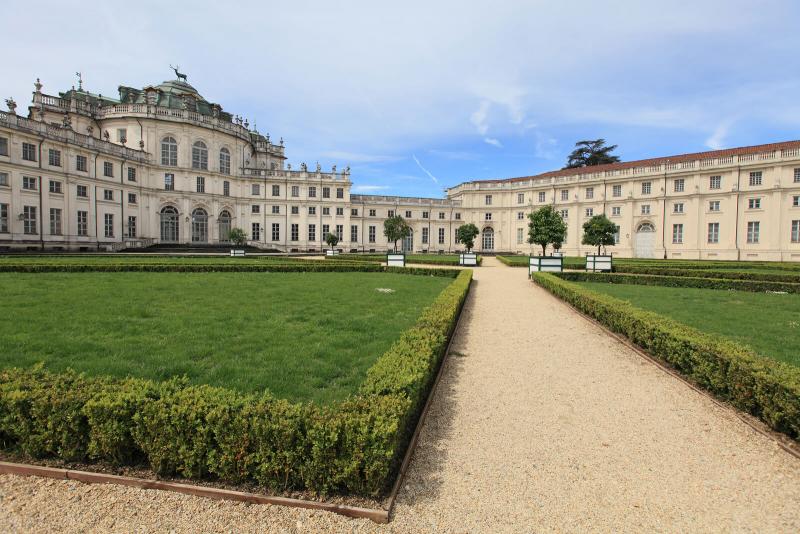Unesco Sites of Italy: The Royal Residences of Turin and Piedmont
ITA:

Use player to listen to Italian version
Turin was for centuries the capital of the kingdom of the House of Savoy, who, between the 17th and 18th centuries, built splendid residences in the city and in the countryside; some functioned as centers of power, others were castles dedicated to hunting, entertainment and courtly life. All of them were meant to symbolize the dynasty’s power and wealth. Fourteen of these magnificent royal residences were inserted by Unesco in their World Heritage list in 1997.
In the heart of Turin is the 17th-century Royal Palace designed by architect Castellamonte, with richly decorated interiors. Nearby is Palazzo Madama, with an elegant façade and staircase commissioned by royal ladies Cristina of France and Maria Giovanna Battista of Savoy-Nemours; also in Turin is the baroque Palazzo Carignano, where Carlo Alberto and Vittorio Emanuele II were born; it was the seat of the first Italian Parliament.
Along the banks of the Po is Valentino Castle, with a distinctly French style, now the seat of a university. Perched on a hill overlooking Turin is Villa della Regina, which features paintings from the 17th and 18th centuries, original period furnishings and a large garden.
Perhaps the most famous palace of the Savoy is the Reggia di Venaria, a former hunting residence, described by many as the ‘Versailles’ of the Savoy. Another notable hunting lodge is Stupinigi, also used for parties and temporary home of Napoleon at the beginning of the 19th century.
The Castle of Moncalieri is one of the oldest structures, built in the Middle Ages for defensive purposes and converted to courtly residence by the Savoy.
Other historic resorts throughout Piedmont include Castello di Agliè, with 300 richly decorated rooms; the Castle of Racconigi, in the province of Cuneo, with a natural park; the Castle of Govone, the summer residence of the Savoy family, with an 18th-century garden, and the Tenuta di Pollenzo, once a wine production center.
Torino fu per secoli la capitale del regno dei Savoia, che tra il XVII° e il XVIII° secolo costruirono splendide residenze in città e in campagna; alcune funzionavano come centri di potere, altre erano castelli dedicati alla caccia, all'intrattenimento e alla vita di corte. Tutte erano destinate a simboleggiare il potere e la ricchezza della dinastia. Quattordici di queste magnifiche residenze reali sono state inserite dall'Unesco nella lista del Patrimonio Mondiale nel 1997.
Nel cuore di Torino si trova il Palazzo Reale del XVII° secolo progettato dall'architetto Castellamonte, con interni riccamente decorati. Nelle vicinanze si trova Palazzo Madama, con un'elegante facciata e scalinata commissionate dalle Madame reali Cristina di Francia e Maria Giovanna Battista di Savoia-Nemours; a Torino si trova anche il barocco Palazzo Carignano, dove nacquero Carlo Alberto e Vittorio Emanuele II; fu la sede del primo Parlamento italiano.
Lungo le rive del Po si trova il Castello del Valentino, in stile francese, ora sede di un'università. Arroccata su una collina che domina Torino è Villa della Regina, con dipinti del 17° e 18° secolo, arredi d'epoca originali e un ampio giardino.
Forse il palazzo più famoso dei Savoia è la Reggia di Venaria, un'antica residenza di caccia, descritta da molti come la ‘Versailles’ dei Savoia. Altra palazzina di caccia notevole è Stupinigi, utilizzata anche per le feste; fu la residenza temporanea di Napoleone all'inizio del XIX° secolo.
Il Castello di Moncalieri è una delle strutture più antiche, costruito nel Medioevo per scopi difensivi e convertito in residenza di corte dai Savoia.
Altre località storiche sparse per il Piemonte includono il Castello di Agliè, con 300 camere riccamente decorate; il Castello di Racconigi, in provincia di Cuneo, con un parco naturale; il Castello di Govone, residenza estiva della famiglia Savoia, con un giardino settecentesco, e la Tenuta di Pollenzo, un tempo centro di produzione vinicola.











